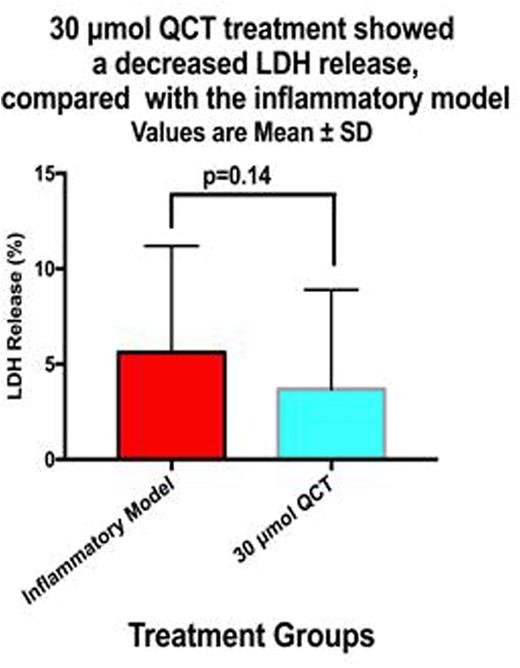Abstract
Background: A higher than normal basal inflammatory state is characteristic of sickle cell disease (SCD). Hydroxyurea (HU) is the only FDA approved drug for SCD. However, HU is a chemotherapy drug and is therefore naturally cytotoxic, often inducing apoptosis. Chronic inflammation in sickle cell patients is invariably associated with injury to the vascular endothelium. Quercetin is a dietary flavonoid found ubiquitously in plants and foods that have anti-oxidative and anti-inflammatory characteristics.
Hypothesis: The dietary flavonoid quercetin will decrease cytotoxic effects of Lipopolysaccharide and HU induced cell damage to vascular endothelial cells.
Aims: 1. to develop an in vitro inflammatory model simulating chronic baseline inflammation observed in sickle cell disease. 2. to test the effect of the physiological dose of hydroxyurea (HU), on the inflammatory model. 3. to examine the role of quercetin (QCT), a dietary flavonoid with anti-oxidative and anti-inflammatory characteristics, for reducing the inflammation.
Methods: Lipopolysaccharide (LPS) was used to induce inflammation in immortalized mouse aortic endothelial cells (iMAECs), providing an in vitro model of inflamed endothelial cells. The cells were exposed to LPS throughout the entire experiment. Interventions included treating the LPS exposed cells with QCT, HU, or QCT + HU over 50 hours. The 50-hour period included 24 hours of varying treatments, followed by two hours of hypoxic exposure and then 24 hours under normal aerobic exposure. Untreated cells (controls) provided a comparison. Data analyses included comparisons of control cells with the inflammatory model, and pairwise comparisons between the inflammatory model and the different treatments. In this experiment lactate dehydrogenase (LDH) was measured by colorimetric assay, as an indication of cell damage.
Results: At the end of the experiment, the LDH level for the inflammatory model was significantly higher than LDH for the control cells (P = 0.0005) fig 1. Treatment with 30 micromoles QCT gleaned a trend toward reduced LDH compared with the inflammatory model (p = 0.1) fig 2. LDH was significantly higher after treatment with 100 micromoles HU compared with the inflammatory model (p = 0.0005) Fig 3. However, LDH was significantly reduced after treatment with a combination of 30 micromoles QCT/100 micromoles HU, compared with 100 micromoles HU alone (p = 0.0008) fig 3.
Conclusions: These results suggest that quercetin may be effective against vascular endothelial cell damage for iMAECs in vitro. It also shows promise in preventing HU-induced cytotoxicity, which was a surprising finding from these results. This latter finding is interesting, and should be given more consideration, since HU is the only FDA-approved drug for treating sickle cell patients, and its use is rapidly increasing.
No relevant conflicts of interest to declare.
Author notes
Asterisk with author names denotes non-ASH members.




This feature is available to Subscribers Only
Sign In or Create an Account Close Modal